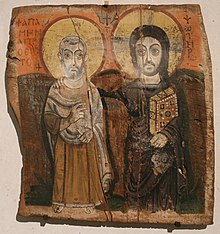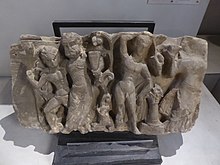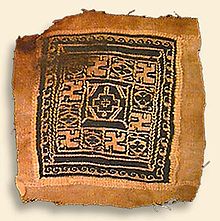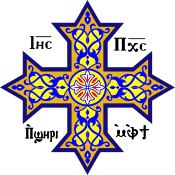
Pope Shenouda III was the 117th Pope of Alexandria and Patriarch of the See of St. Mark. His papacy lasted 40 years, 4 months, and 4 days, from 14 November 1971 until his death.
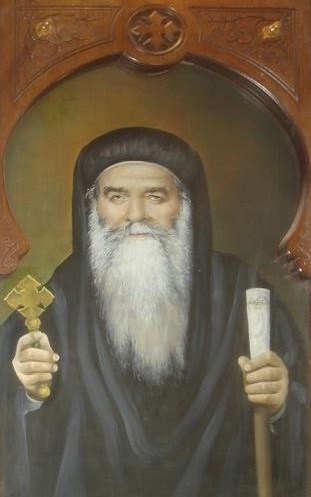
Pope Cyril VI of Alexandria also called Abba Kyrillos VI, Coptic: Ⲡⲁⲡⲁ Ⲁⲃⲃⲁ Ⲕⲩⲣⲓⲗⲗⲟⲥ ⲋ̅ ;, was the 116th Pope of Alexandria and Patriarch of the See of St. Mark from 10 May 1959 to his death.
Isaac Fanous was an Egyptian Copt iconographer, scholar and theologian, who single-handedly founded the most popular style of contemporary Coptic art today, commonly referred to as "Neo-Coptic".

Ester Akhnoukh Fanous or Esther Fanous, also known as Ester Wissa was an Egyptian feminist. She was a founding member of the New Woman Society and helped found the Women's Wafd Central Committee in 1920. Her son Hanna Fahmy Wissa has written about her in his family memoir Assiout.

Menas of Egypt, a martyr and wonder-worker, is one of the most well-known Coptic saints in the East and the West, due to the many miracles that are attributed to his intercession and prayers. Menas was a Coptic soldier in the Roman army martyred because he refused to recant his Christian faith. The common date of his commemoration is November 11, which occurs 13 days later on the Julian calendar.
Ramses Wissa Wassef (1911–1974) was an Egyptian Coptic architect and professor of art and architecture at the College of Fine Arts in Cairo and founder of the Ramses Wissa Wassef Art Centre.

The Coptic Museum is a museum in Coptic Cairo, Egypt with the largest collection of Coptic Christian artifacts in the world. It was founded by Marcus Simaika in 1908 to house Coptic antiquities. The museum traces the history of Egypt from its beginnings to the present day. It was erected on 8,000 square meter land offered by the Coptic Orthodox Church, under the guardianship of Pope Cyril V.

Saint Virgin Mary's Coptic Orthodox Church, also known as the Hanging Church, is one of the oldest churches in Egypt which dates to the third century. It belongs to the Coptic Orthodox Church of Alexandria.

Coptic Cairo is a part of Old Cairo which encompasses the Babylon Fortress, the Coptic Museum, the Hanging Church, the Greek Church of St. George and many other Coptic churches and historical sites. It is believed in Christian tradition that the Holy Family visited this area and stayed at the site of Saints Sergius and Bacchus Church. Coptic Cairo was a stronghold for Christianity in Egypt both before and during the Islamic era, as most of its churches were built after the Muslim conquest of Egypt in the 7th century.
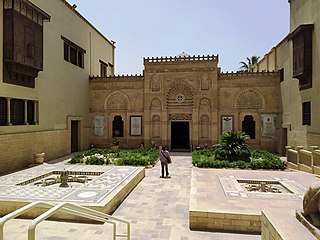
Coptic architecture is the architecture of the Coptic Christians, who form the majority of Christians in Egypt.
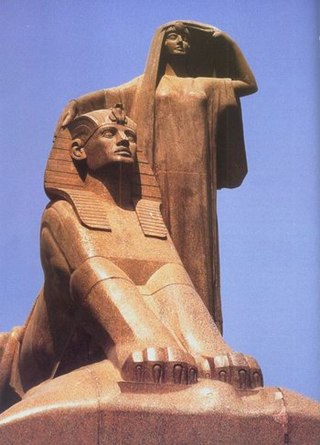
Mukhtar Museum is a museum in Cairo, Egypt, housing the sculptures of Mahmoud Mokhtar. Mokhtar is considered to be significant as the father of modern Egyptian sculpture. His tomb is in the basement of the museum.

The Coptic Orthodox Church of St. Barbara is one of the many famous Coptic Orthodox parishes that can be found in the district of Coptic Cairo. The building is located on the eastern part of the Babylon Fortress and is one of the oldest buildings in Cairo, dating back to the 5th or 6th century AD. However, like many other buildings of Coptic architecture, it was rebuilt several times, most notably by the end of the 11th century.
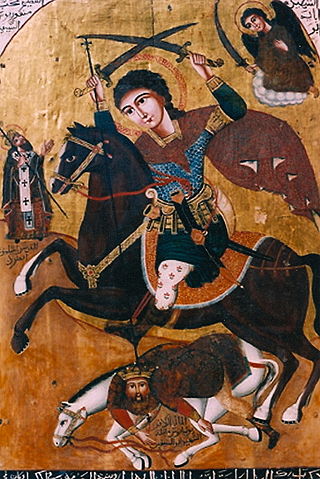
Yuhanna al-Armani al-Qudsi was an artist of Armenian origin in Ottoman Egypt. He is most notable for his religious works, especially his Coptic icons that decorate The Hanging Church in Old Cairo.

Adam Henein was an Egyptian sculptor.
Habib Gorgi (1892–1965) was an artist of the turn of the century pioneer generation of Egyptian modern art. He graduated from Teacher Training School then received a scholarship to England in 1920 to study pedagogic methods of art teaching, and watercolors. An early pioneer of art education, and the author of the first Arabic book on the subject in 1936. He taught graduates of the Fine and Applied Arts Colleges to prepare them to become arts teachers and get their National Teacher's Certificate. He established the Art Advocates Society in 1928 for artist investigating Egyptian identity through art, and watercolors in particular. His Spontaneous Sculpture School and the Textile Drawing School was continued by son-in-law Ramses Wissa Wassef in Harraneya. He represented Egypt in conferences on art teaching in Paris from 1936, and his educational experiments became an inspiration to major international writers, including Wilhelm Viola, in his book The Art of the Child. During his scholarship period in England, he specialized in watercolours. Habib Georghe was interested in the aesthetics of Egyptian art, and adopted this through his call for painting Egyptian landscapes, and through his establishing the Folk Art School, where he fostered a number of spontaneous artists, including Sayeda Massak, Samira Hosny, Yehya Bu Seri', Bodour Girgis, who were all talented in environmental sculpture, in the period from 1938 to 1951.
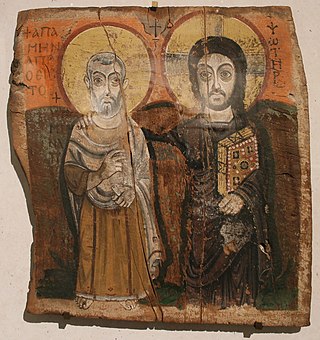
The Icon of Christ and Abbot Mena a Coptic painting which is now in the Louvre museum, in Paris. The icon is an encaustic painting on wood and was brought from the Apollo monastery in Bawit, Egypt. The icon measures about 57 by 57 centimetres and is 2 centimetres thick. The icon has been damaged over the years with some of the pigment missing and it has two vertical cracks running through the image, but it can still be readily made out.

The following outline is provided as an overview of and topical guide to Cairo:

Copto-Arabic literature is the literature of the Copts written in Arabic. It is distinct from Coptic literature, which is literature written in the Coptic language.
